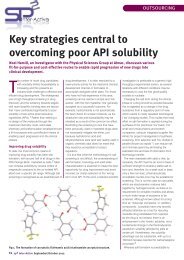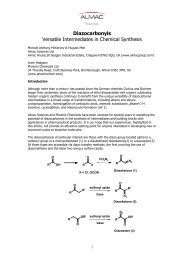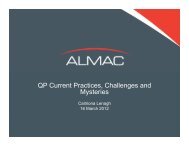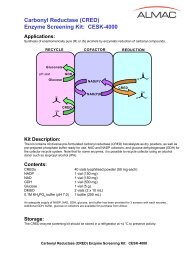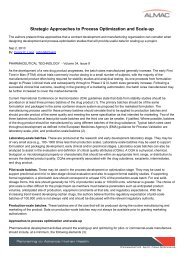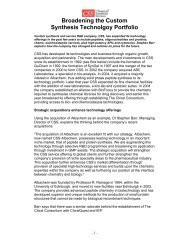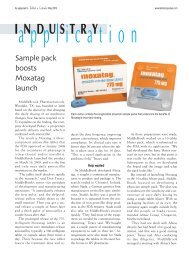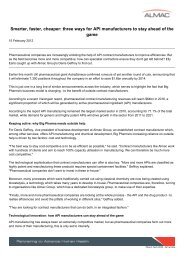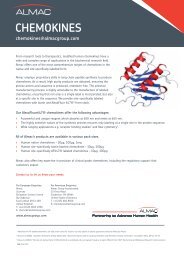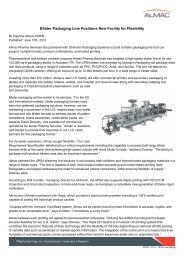Achieving faster formulation of solid oral dosage forms for ... - Almac
Achieving faster formulation of solid oral dosage forms for ... - Almac
Achieving faster formulation of solid oral dosage forms for ... - Almac
Create successful ePaper yourself
Turn your PDF publications into a flip-book with our unique Google optimized e-Paper software.
If the API possesses poor physicochemical properties - e.g. poor aqueous solubility such as BiopharmaceuticsClassification System class II or IV compounds - then API-in-capsule may not be appropriate, as some <strong><strong>for</strong>mulation</strong>development work will be required to investigate the potential benefits <strong>of</strong> functional excipients, such as solubilisingagents, which may be required to improve bioavailability. This is an important point, as too <strong>of</strong>ten organizations in a hurrycan overlook the potential impact <strong>of</strong> the API properties when determining their pharmaceutical development strategy andAPI batch sizes. While all the in<strong>for</strong>mation may not be available, sufficient data will have usually been generated during thelead optimization stage <strong>of</strong> discovery to enable an in<strong>for</strong>med prediction on the likely <strong><strong>for</strong>mulation</strong> strategy.Another property to consider is the bulk density <strong>of</strong> the API, as most API-in-capsule machines do not possess a 'tamping'feature. Consequently, the bulk density and the way the drug particles pack have a direct effect on the amount <strong>of</strong> API thatcan fit into a capsule. There<strong>for</strong>e, the dose is essentially limited by the size <strong>of</strong> the capsule.It is well known that micronized powders possess poor flow properties, and this can result in issues with both the API-incapsulemachines and capsule boards. For example, the high throughput unit (HTU) <strong>of</strong> the Xcelodose automatically refillsthe dispense head with API, but a certain degree <strong>of</strong> flowability is required so that the API can be transferred from the HTUhopper into the dispense head. Capsule boards can also be affected by poor flow properties, as the filling process can beirregular, leading to variability in dose/fill weight. Not only is the particle size <strong>of</strong> the API to be considered whendetermining if API-in-capsule is a suitable strategy, but the distribution can also have an influence. If the API possesses awide particle size distribution, then it may not be suitable <strong>for</strong> the Xcelodose. Potentially small particles may pass throughthe dispense head into the capsule, with the larger particles retained. This could lead to having to stop and clean thedispense head at regular intervals, resulting in increased downtime. It is worth noting, however, that careful selection <strong>of</strong>the dispense head and sieving the API to narrow the particle size distribution could assist in overcoming this issue.In summary, if the physicochemical properties <strong>of</strong> the API are good, then API-in-capsule using a manual fill, capsuleboards or Xcelodose system should be possible. Considera-tion should also be given to the likely doses and the quantity<strong>of</strong> capsules required in determining whether the Xcelodose is an appropriate piece <strong>of</strong> equipment to use.Direct Cost Savings withAPI-in-capsule using the XcelodoseAPI usage: In early development, API is usually in short supply, with material being needed <strong>for</strong> toxicology and DMPKstudies, analytical development, API characterization studies, and <strong><strong>for</strong>mulation</strong> development. Although API is usuallyrelatively expensive at this stage <strong>of</strong> development, one <strong>of</strong> the benefits <strong>of</strong> the Xcelodose system is that only small quantities<strong>of</strong> API are required to determine operating parameters.Typically ~5g <strong>of</strong> API is required to develop Xcelodose filling parameters, such as, tap frequency, pulse width, amount <strong>of</strong>slow tapping and high throughput unit settings.Compared to usage expected by developing a <strong>dosage</strong> <strong>for</strong>m using the "commercial <strong><strong>for</strong>mulation</strong> approach," 5g is acceptedas a reasonable amount <strong>of</strong> API <strong>for</strong> drug product development. Furthermore, from a scheduling perspective, development<strong>of</strong> Xcelodose operating parameters can be left until immediately prior to GMP operations - meaning that the projectmanager has one less aspect to worry about when allocating API from earlier development batches.Direct labor hours: Four to six weeks <strong>of</strong> development time is usually required <strong>for</strong> a "fit <strong>for</strong> purpose" <strong><strong>for</strong>mulation</strong> in earlydevelopment following the commercial approach. Although the <strong><strong>for</strong>mulation</strong> scientist will not be 'hands on' <strong>for</strong> all <strong>of</strong> thistime, they will be reasonably busy interpreting excipientcompatibility data, manufacturing prototype blends and stabilitybatches <strong>of</strong> the <strong>dosage</strong> units, and writing protocols/reports. In contrast, API-in-capsule negates the initial need <strong>for</strong> lengthyexcipient compatibility, blend feasibility and probe stability studies.In order to manufacture API-in-capsule supplies <strong>for</strong> clinical use, traditional methods have included hand-filling, andoccasionally the use <strong>of</strong> capsule boards. Hand-filling is certainly not rapid, and if the weight required is low - <strong>for</strong> example,tens <strong>of</strong> milligrams or less - this filling process may take up to five minutes per capsule.2Capsule boards can produce filledContract Pharma ‐ May 2011 ‐ Oral Dosage FD
capsules quicker than hand-filling, but can result in large losses <strong>of</strong> API as the process is not particularly "clean." A furtherproblem is that the use <strong>of</strong> capsule boards does not lend itself to low dose fills, as small volume dosing plates can lead tonon-reproducible fills particularly <strong>for</strong> poor flowing APIs. In contrast, the Xcelodose can fill a wide range <strong>of</strong> weights,including very low weights both accurately and relatively quickly. Once a suitable set <strong>of</strong> parameters has been developed<strong>for</strong> the API in question, there is little need <strong>for</strong> direct labor.Indirect Cost Savings withAPI-in-capsule using the XcelodoseIn addition to the direct cost savings outlined above, there are many more indirect savings that can be achieved by usingan API-in-capsule approach. Some <strong>of</strong> these are highlighted below:AnalyticsSimplifies analytical development: The analytical methods that have been developed <strong>for</strong> the API will most likely besuitable, with little or no analytical development. In the majority <strong>of</strong> cases, one would not expect specificity issues, makingthe assay method particularly straight<strong>for</strong>ward <strong>for</strong> the analytical group. If the API is particularly soluble in acid conditionsone could argue that the API-in-capsule approach can remove the need <strong>for</strong> a dissolution method.Content uni<strong>for</strong>mity: The API-in-capsule approach removes the need <strong>for</strong> conducting content uni<strong>for</strong>mity testing. This isbecause a record <strong>of</strong> every fill weight, and in<strong>for</strong>mation on the distribution <strong>of</strong> fill weights around the target fill, is availablefrom the Xcelodose 600. Frequently, results will give an RSD <strong>of</strong> 2% to 3% and equate to a weight typically within 1% <strong>of</strong>target.3 The data recorded is fully compliant with 21CFR part 11, and is saved as a pdf file that can be printed but notedited. If capsules are hand-filled, the weight <strong>of</strong> each capsule produced must be checked to ensure that it is within limits.This is achieved by reviewing the balance printouts, which can be a very time-consuming process.Stability: Typically <strong>for</strong> API-in-capsule drug products, our clients focus their Clinical Trial Application (CTA) stabilityjustifications around the drug substance stability data. This data is used as primary evidence to justify shelf life <strong>for</strong> thedrug product. Typically, when this strategy is employed, clients commit to a CTA that places the API-in-capsule clinicalbatch(es) on storage, providing updates to the CTA as data becomes available. This strategy helps accelerate theprogram through to clinical trial, as there is no need to wait <strong>for</strong> product stability data to become available.Cleaning methods: The cost <strong>of</strong> replacing the contact parts on the Xcelodose is significantly cheaper than the costrequired to develop a cleaning verification method. Another consideration is time; developing a cleaning verificationmethod can take weeks <strong>of</strong> work, and that time could be spent developing the Xcelodose method, and indeed, startingmanufacture <strong>of</strong> the clinical product.Ease <strong>of</strong> containment: A lack <strong>of</strong> toxicity data <strong>for</strong> compounds entering FIH studies is common, and there<strong>for</strong>e to ensureoperator safety protection, the Xcelodose can be used within the Xcelohood. This means potentially toxic compoundscan be easily contained within the Xcelohood system.Mitigation <strong>of</strong> Risks Associated with the Commercial Formulation ApproachIt is not uncommon in early development to encounter differences in particle size, hygroscopicity, polymorph content andcrystallinity <strong>of</strong> the API. Such changes in the API during chemical development can result in headaches <strong>for</strong> themultidisciplinary team working on the commercial <strong><strong>for</strong>mulation</strong> ap-proach. For example, a change in flow properties canaffect blending time, roller compaction settings, and compression or encapsulation parameters, resulting in lengtheningtimelines, more development work and there<strong>for</strong>e increased costs. Physicochemical characterization is still extremelyimportant and API properties can have a significant effect on the processing parameters <strong>for</strong> the Xcelodose.However, a change in API characteristics when using this approach would most likely result in only one or two days <strong>of</strong>additional time <strong>for</strong> optimization <strong>of</strong> Xcelodose processing parameters.Contract Pharma ‐ May 2011 ‐ Oral Dosage FD
Blending excipients and a drug together can be difficult, especially when attempting to attain uni<strong>for</strong>mity at low startingdoses. Segregation <strong>of</strong> the components, sampling bias and the need <strong>for</strong> a blend uni<strong>for</strong>mity method are all challengesassociated with the commercial approach. All <strong>of</strong> these factors are negated with the exploratory <strong><strong>for</strong>mulation</strong> approach.Case StudyA client approached us requesting supplies <strong>for</strong> a FIH study. Initial requirements were <strong>for</strong> less than 1000 capsules <strong>of</strong> twodifferent <strong>dosage</strong> strengths. No <strong><strong>for</strong>mulation</strong> studies were to take place, as the client wanted to save time and API <strong>for</strong>reasons outlined previously. A decision was taken to manufacture these supplies manually using an analytical balance.The client subsequently contacted us about a re-supply <strong>of</strong> 25 mg and 100 mg capsules in quantities <strong>of</strong> greater than10,000 and 5,500, respectively. It was quickly decided that an automated process was the best solution <strong>for</strong> manufacture<strong>of</strong> re-supplies.The API possessed poor flow properties and was treated as a potent compound (Operator Exposure Limit <strong>of</strong> between 0.110 g/m3) due mainly to the lack <strong>of</strong> toxicological in<strong>for</strong>mation available. This re-supply project was there<strong>for</strong>e a good fit <strong>for</strong>the Xcelodose system, in combination with the potent handling capabilities <strong>of</strong> the Xcelohood.From the <strong>solid</strong> state characterization package, the particle size distribution <strong>of</strong> the batch <strong>of</strong> API to be used <strong>for</strong> the re-supplyis shown in Table 1 (below):This in<strong>for</strong>mation, coupled with flowability data, suggested that the API possessed poor flow properties. Although poor flowdoes not impact hand-filling, it was thought that poor flow may cause issues with the Xcelodose, particularly when usingthe high throughput unit, where the API must flow from the hopper into the dispense head. However, with this API, it waspossible to adjust the frequency <strong>of</strong> the vibrations and the angle <strong>of</strong> the hopper to allow a reasonable flow <strong>of</strong> API into thedispense head.Overall, this project was completed within three weeks (single shift, 40-hour working week). Less than one day wasrequired to determine suitable processing parameters <strong>for</strong> the 25 mg and 100 mg strengths.The low-fill-weight capsules took approximately 76 hours to complete, whereas the larger-fill-weight capsules werecompleted in just over 36 hours.When the initial clinical supplies were manufactured by hand-filling, the average rate <strong>of</strong> production <strong>of</strong> 25 mg and 100 mgcapsules was 30 and 50 capsules per hour, respectively. There<strong>for</strong>e, if the Xcelodose had not been available <strong>for</strong> the resupply,manual capsule filling would have required approximately 400 hours to complete the 25 mg fill and 110 hours <strong>for</strong>the larger fill (see Figure 2).Contract Pharma ‐ May 2011 ‐ Oral Dosage FD
Figure 2: Timelines using the Xcelodosecompared to hand-fillingIt is also worth noting that, as commonly seen with FIH studies, there was a lack <strong>of</strong> toxicology in<strong>for</strong>mation about the API.There<strong>for</strong>e, in order to ensure protection <strong>of</strong> the operators, the original supplies were manufactured within a ventilatedbalance safety enclosure (VBSE). However, because the analytical balance was in direct contact with the VBSE, anyvibration from the unit resulted in difficulties with balance taring. For the re-supply operation, the Xcelodose was usedwithin the specially designed Xcelohood system. As the Xcelodose is not directly in contact with the Xcelohood, themicro-balance used by the Xcelodose is inherently more stable and results in much quicker taring.There are a number <strong>of</strong> approaches <strong>for</strong> the manufacture <strong>of</strong> supplies in FIH studies, including ones we've implemented.With the increasingly favored exploratory <strong><strong>for</strong>mulation</strong> approach, possible manufacturing options include hand-filling,capsule boards and the Xcelodose. This article has explored the direct and indirect benefits <strong>of</strong> using the Xcelodose. In thecase study, the direct cost savings <strong>of</strong> the Xcelodose were shown in terms <strong>of</strong> direct labor costs, with clinical suppliesdelivered approximately seven weeks earlier than if a hand-filling operation had been employed. In addition, timelines <strong>for</strong>this project were aided further by the fact that no cleaning method was required, meaning development <strong>of</strong> the Xcelodoseprocess parameters could start immediately. Finally, only 5g <strong>of</strong> API was required <strong>for</strong> development activities and, coupledwith minimal losses during processing, resulted in less API usage when compared to a hand-filling approach, andsignificantly less API usage, than would have been required <strong>for</strong> development using a commercial <strong><strong>for</strong>mulation</strong> approach.If the exploratory <strong><strong>for</strong>mulation</strong> approach is suitable, and speed to clinical is imperative, then we have found the Xcelodosesystem a viable option <strong>for</strong> the manufacture <strong>of</strong> supplies <strong>for</strong> FIH studies. However, if time and API supply are not <strong>of</strong> theessence, then we will work with client partners on a strategic commercial <strong><strong>for</strong>mulation</strong> approach to develop a suitable<strong>dosage</strong> <strong>for</strong>m, fit <strong>for</strong> purpose <strong>for</strong> clinical supply.References1. Hariharan M, et al., Reducing the time to develop and manufacture <strong><strong>for</strong>mulation</strong>s <strong>for</strong> First Oral Dose in HumansPharmaceutical Technology 20032. Bryant, s. et al., Advantages in powder-dosing technology Innovations in Pharmaceutical Technology 95-100 (2002)3. Capsugel website. http://www.capsugel.comColin Lorimer, Ph.D. MPSNI, is senior <strong><strong>for</strong>mulation</strong> scientist at <strong>Almac</strong>. He has worked in the pharmaceutical industry <strong>for</strong>more than eight years and has practical experience <strong>of</strong> interpreting <strong>solid</strong> state in<strong>for</strong>mation pertinent to <strong><strong>for</strong>mulation</strong>development. Specializing in <strong>solid</strong> <strong>oral</strong> <strong>dosage</strong> <strong><strong>for</strong>ms</strong>, he has worked on many <strong><strong>for</strong>mulation</strong>s <strong>for</strong> early stage developmentusing various technologies. He can be reached at colin.lorimer@almacgroup.com.Contract Pharma ‐ May 2011 ‐ Oral Dosage FD





